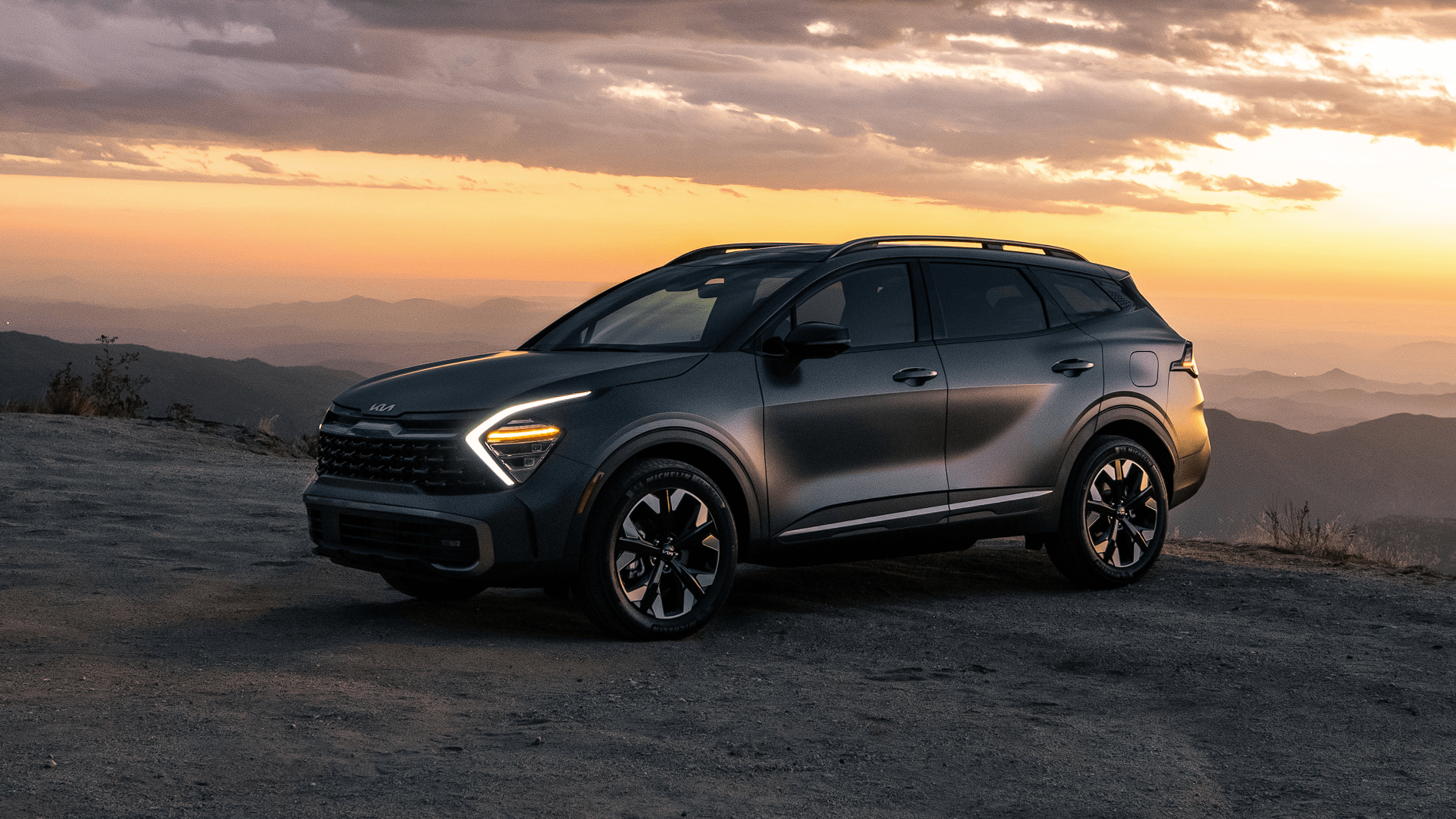Kia Sportage PHEV 2023 Brake System
The 2023 Kia Sportage PHEV’s brake system is a great example of how modern car engineering can make cutting-edge technology work with tried-and-true safety measures. This high-tech system not only provides strong stopping power, but it also cares about the environment by using regenerative braking to turn moving energy into electrical energy, which increases the range of electric vehicles. The Sportage PHEV has electronic brake-force distribution, anti-lock systems, and traditional hydraulic brakes. This gives you better control and stability when you stop, which makes the car safer on the road. Kia’s dedication to safety is shown by features like automatic emergency stopping and brake assist. Other features, like hill descent control, make the cars more capable of going off-road. Basically, the 2023 Kia Sportage PHEV’s brake system strikes a good mix of performance, safety, and environmentally friendly driving. This shows how committed Kia is to coming up with new ways to solve problems in the automotive industry.
2023 KIA SPORTAGE Specs, Price, Features and Mileage (Brochure)
Brake system
Your vehicle has power-assisted brakes, parking brake, and various braking sys-tems for safe driving.
Power brakes
Your vehicle has power-assisted brakes that adjust automatically through nor-mal usage.
In the event that the power-assisted brakes lose power because of a stalled engine or some other reason, you can still stop your vehicle by applying greater force to the brake pedal than you normally would. The stopping distance, however, will be longer.
When the engine is not running, the reserve brake power is partially depleted each time the brake pedal is applied. Do not pump the brake pedal when the power assist has been interrupted.
Pump the brake pedal only when necessary to maintain steering control on slippery surfaces.
NOTICE
- When stepping on the brake pedal under a certain driving or weather condition. you may witness your car make a sound of squealing or some other noises. This is not a brake malfunction but a normal phenomenon
- When driving on the road to which deicing chemicals are applied, the vehicle may witness noises from the brake or abnormal abrasion of tires because of such deicing chemicals. You should operate brake additionally so that you would be able to remove the deicing chemicals on the brake disk and pad under a safe traffic condition.
CAUTION
Brake pedal
Do not drive with your foot resting on the brake pedal. This will create abnormally high brake temperatures which can cause excessive brake lining and pad wear.
WARNING
HEV driving down hill
Do not turn off the vehicle while going down a hill. The brake booster may not work sufficiently and the braking distance may be longer.
WARNING
Steep hill braking
Avoid continuous application of the brakes when descending a long or steep hill by shifting to a lower gear. Continuous brake application will cause the brakes to overheat and could result in a temporary loss of braking performance.
Wet brakes may impair the vehicle’s ability to safely slow down; the vehicle may also pull to one side when the brakes are applied. Applying the brakes lightly will indicate whether they have been affected in this way. Always test your brakes in this fashion after driving through deep water. To dry the brakes, apply them lightly while maintaining a safe forward speed until brake performance returns to normal.
In the event of brake failure
If service brakes fail to operate while the vehicle is in motion, you can make an emergency stop with the parking brake. The stopping distance, however, will be much greater than normal.
WARNING
Parking brake
Avoid applying the parking brake to stop the vehicle while it is moving except in an emergency situation. Applying the parking brake while the vehicle is moving at normal speeds can cause a sudden loss of control of the vehicle. If you must use the parking brake to stop the vehicle, use great caution in applying the brake.
Brake Over Accelerator
In the event the accelerator pedal becomes stuck or entrapped, apply steady and firm pressure to the brake pedal to slow the vehicle and reduce engine power.
If you experience this condition, take the following steps:
- Apply the brakes and bring your vehicle to a safe stop.
- Move the transmission to P (Park), switch the engine off and apply the parking brake.
- Inspect the accelerator pedal for any interference.
If none are found and the condition persists, have your vehicle towed to an authorized Kia dealer.
Disc brakes wear indicator
When your brake pads are worn and new pads are required, you will hear a high-pitched warning sound from your front brakes or rear brakes. You may hear this sound come and go or it may occur whenever you press the brake pedal.
Always replace the front or rear brake pads as pairs.
CAUTION
Replace brake pads
Do not continue to drive with worn brake pads. Continuing to drive with worn brake pads can damage the braking system and result in costly brake repairs.
WARNING
Brake wear
Do not ignore high-pitched wear sounds from your brakes. If you ignore this audible warning, you will eventually lose braking performance, which could lead to a serious accident.
NOTICE
Brake dust may accumulate on the wheels, even under normal driving conditions. Some dust is inevitable as the brakes wear and contribute to brake noise.
Electronic Parking Brake (EPB)
After parking the vehicle, apply the Electronic Parking Brake (EPB) to prevent the vehicle from being moved by the external force.
Applying the parking brake
Applying the parking brake with EPB switch

- Depress the brake pedal.
- Pull up the EPB switch.
Make sure the warning light comes on.
Also, the EPB is applied automatically if the Auto Hold button is on when the vehicle is turned off. In addition, if you pull up the EPB switch after the vehicle is turned off, the EPB will be applied.
WARNING
Never leave children and animals unattended in the vehicle. If you leave children unaccompanied in the vehicle, they may be able to set the vehicle in motion, for example by:
- Releasing the parking brake.
- Shifting the transmission out of P (Park) position.
- Starting the engine.
In addition, they may operate vehicle equipment.
NOTICE
On a steep incline or when pulling a trailer, if the vehicle does not remain at a standstill, do as follows:
- Apply the EPB.
- Pull up the EPB switch for more than 3 seconds.
Do not operate the EPB while the vehicle is moving except in an emergency situation.
NOTICE
A click or electric brake motor whine sound may be heard while operating or releasing the EPB.
These conditions are normal and indicate that the EPB is functioning properly.
Automatic application of EPB
The EPB is applied automatically under following conditions.
- Engine OFF while AUTO HOLD is enabled
- Conditions below while AUTO HOLD is activated
- Driver’s door is opened
- Hood is opened
- Liftgate is opened
- Vehicle stops for more than approximately 10 minutes
- Vehicle stops on a steep slope
- Requested by other systems
NOTICE
For Electronic Parking Brake (EPB) equipped vehicles with AUTO HOLD function used while driving, if the ENGINE START/STOP button has been turned OFF, the EPB will be engaged automatically. Therefore,
AUTO HOLD function should be turned off before the ENGINE START/STOP button is turned off.
Emergency braking with the EPB switch
If there is a problem with the brake pedal while driving, emergency braking is possible by pulling up and holding the EPB switch.
Braking is possible only while you are holding the EPB switch.
WARNING
Do not operate the Electronic Parking Brake (EPB) while the vehicle is moving except in an emergency situation. Apply-ing the EPB while the vehicle is moving at normal speeds can cause a sudden loss of control of the vehicle. If you must use the EPB to stop the vehicle, use great caution in applying the brake.
NOTICE
During emergency braking by the EPB, the parking brake warning light will appear to indicate that the system is operating.
If you notice a continuous noise or burn-ing smell when the EPB is used for emergency braking, have your vehicle checked by an authorized Kia dealer.
Releasing the parking brake with EPB switch
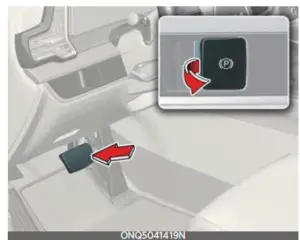
Releasing the parking brake with EPB switch,
- Have the ENGINE START/STOP but-ton in the ON position.
- Press the brake pedal.
- Press the EPB switch.
- Make sure the brake warning light goes off.
Automatic release of EPB
The EPB is released automatically under following conditions.
- Gear in P (Park)
- With the engine running, engage the brake pedal and shift out of P (Park) to R (Reverse) or D (Drive).
- Gear in N (Neutral)
- With the engine running, engage the brake pedal and shift out of N (Neutral) to R (Reverse) or D (Drive).
- Automatic transmission
- Start the engine.
- Fasten the driver’s seat belt.
- Close the driver’s door, hood and liftgate.
- Press the accelerator pedal while the gear is in R (Rear), D (Drive) or Sports mode.
Make sure the brake warning light goes off.
NOTICE
- For your safety, you can engage the EPB even though the ENGINE START/STOP button is in the OFF position, but you cannot release it.
- For your safety, press the brake pedal and release the parking brake manu-ally with the EPB switch when you drive downhill or when backing up the vehicle.
Do not follow the above procedure when driving on a flat level ground. The vehi-cle may suddenly move forward.
NOTICE
If the parking brake warning light is still on even though the EPB has been released, have the system checked by an authorized Kia dealer.
CAUTION
Do not drive your vehicle with the EPB applied. It may cause excessive brake pad and brake rotor wear.
EPB warning
The EPB will display a warning message with sound under certain conditions.
- If you try to drive off while engaging the accelerator pedal with the EPB applied, but the EPB doesn’t release automatically, a warning will sound and a message will appear.
- If the driver’s seat belt is not fastened and the vehicle hood, driver’s door or liftgate is opened, a warning will sound and a message will appear.
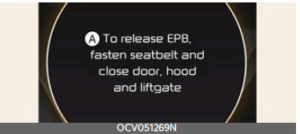
A: To release EPB, fasten seatbelt and close door, hood and liftgate
If there is a problem with the vehicle, a warning may sound and a message
may appear.
If the above situation occurs, press the brake pedal and release EPB by pressing the EPB switch.
WARNING
Parking Brake Use
- Never allow a passenger to touch the parking brake. If the parking brake is released unintentionally, serious injury may occur.
- All vehicles should always have the parking brake fully engaged when parked to avoid inadvertent move-ment of the vehicles which can injure occupants or pedestrians.
- A click or electric brake motor whine sound may be heard while operating or releasing the EPB. These conditions are normal and indicate that the EPB is functioning properly.
- When leaving your keys with a parking lot attendant or valet, make sure to inform him/her how to operate the EPB.
- The EPB may malfunction if you drive with the EPB applied.
- When you automatically release EPB by pressing the accelerator pedal, press it slowly.
When the conversion from Auto Hold to EPB is not working properly a warning will sound and a message will appear.
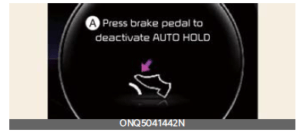
A: Press brake pedal to deactivate AUTO HOLD
NOTICE
Engage the brake pedal when the above message appears for the Auto Hold and EPB may not activate.
If the EPB is applied while Auto Hold is activated because of an Electronic Stability Control (ESC) signal, a warning will sound and a message will appear..
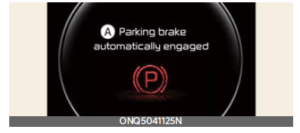
A: Parking brake automatically engaged
EPB malfunction indicator
This warning light appears if the ENGINE START/STOP button is changed to the ON position and goes off in approximately 3 seconds if the system is operating normally.
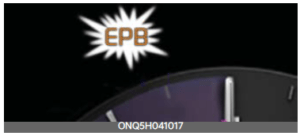
If the EPB malfunction indicator remains on, comes on while driving, or does not come on when the ENGINE START/STOP button is changed to the ON posi-tion, this indicates that the EPB may have malfunctioned.
If this occurs, have your vehicle checked by an authorized Kia dealer.
The EPB malfunction indicator may appear when the ESC indicator comes on to indicate that the ESC is not working properly, but it does not indicate a malfunction of the EPB.
NOTICE
The EPB warning light may appear if the EPB switch operates abnormally. Shut the engine off and turn it on again after a few minutes. The warning light will go off and the EPB switch will operate normally. However, if the EPB warning light is still on, have the system checked by an authorized Kia dealer.
If the parking brake warning light does not appear or blinks even though the EPB switch was pulled up, the EPB is not applied.
If the parking brake warning light blinks when the EPB warning light is on, press the EPB switch, then pull it up. Once more press it back to its original position and pull it back up. If the EPB warning does not go off, have the system checked by an authorized Kia dealer.
When the EPB is not released
If the EPB does not release normally, take your vehicle to an authorized Kia dealer by loading the vehicle on a flat-bed tow truck and have the system checked.
2023 KIA SPORTAGE Specs, Price, Features and Mileage (Brochure)
AUTO HOLD (if equipped)
The Auto Hold is designed to maintain the vehicle in a standstill even though the brake pedal is not pressed after the driver brings the vehicle to a complete stop by pressing the brake pedal.
Applying Auto Hold function
- Press the brake pedal and start the vehicle.
- Press the Auto Hold button. The white AUTO HOLD indicator will come on indicating the system is in standby.
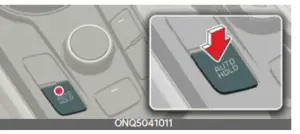
Before the Auto Hold will engage, the driver’s door and engine hood must be closed.

When coming to a complete stop by pressing the brake pedal, the AUTO HOLD indicator changes from white to green indicating the AUTO HOLD is engaged. The vehicle will remain at a standstill even if you release the brake pedal.
If EPB is applied, Auto Hold will be released.
If you press the accelerator pedal with the gear in D (Drive) or Manual mode, the Auto Hold will be released automatically and the vehicle will start to move. The indicator changes from green to white indicating the Auto Hold is in standby and the EPB is released.
When driving off from Auto Hold by pressing the accelerator pedal, always check the surrounding area near your vehicle.
Slowly press the accelerator pedal for a smooth launch.
Canceling Auto Hold function

- To cancel the Auto Hold operation, press the Auto Hold switch. The AUTO HOLD indicator will go out.
- To cancel the Auto Hold operation when the vehicle is at a standstill, press the Auto Hold switch while pressing the brake pedal.
NOTICE
- The following are conditions when the Auto Hold will not engage (Auto Hold light will not turn green and the Auto Hold system remains in stand-by):
- The driver’s door is opened
- The engine hood is opened
- The gear is in P (Park)
- The gear is in R (Reverse)
- The EPB is applied
- For your safety, the Auto Hold automatically switches to EPB under any of the following conditions (Auto Hold light remains white and the EPB automatically applies):
- The driver’s door is opened.
- The engine hood is opened.
- The vehicle is in a standstill for more than 10 minutes.
- The vehicle is standing on a steep slope.
- The vehicle moved for a few seconds.
In these cases, the brake warning light comes on, the AUTO HOLD indicator changes from green to white, and a warning sounds and a message will appear to inform you that EPB has been automatically engaged. Before driving off again, press foot brake pedal, check the surrounding area near your vehicle and release parking brake manually with the EPB switch.
- If the AUTO HOLD indicator lights up yellow, the Auto Hold is not working properly. Take your vehicle and have the system checked by an authorized Kia dealer.
WARNING
To reduce the risk of an accident, do not activate Auto Hold while driving down-hill, backing up or parking your vehicle.
If there is a malfunction with the driver’s door, liftgate or engine hood open detection system, the Auto Hold may not work properly.
Take your vehicle and have the system checked by an authorized Kia dealer.
NOTICE
A click or electric brake motor whine sound may be heard while operating or releasing the EPB, but these conditions are normal and indicate that the EPB is functioning properly.
Warning messages
The Auto Hold function will display a warning message with sound under certain conditions.
When the EPB is applied from Auto Hold, a warning will sound and a message will appear.
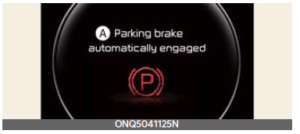
A: Parking brake automatically engaged
When the conversion from Auto Hold to EPB is not working properly a warning will sound and a message will appear.
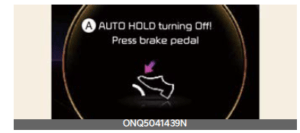
A: AUTO HOLD turning Off! Press brake pedal
NOTICE
When this message is displayed, the Auto Hold and EPB may not operate. For your safety, press the brake pedal.
If you do not apply the brake pedal when you release the Auto Hold by pressing the [AUTO HOLD] switch, a warning will sound and a message will appear.
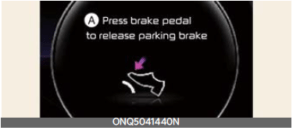
A: Press brake pedal to deactivate AUTO HOLD
When you press the [AUTO HOLD] switch, if the driver’s door and engine hood are not closed, a warning will sound and a message will appear on the LCD display.
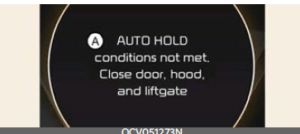
A: AUTO HOLD conditions not met. Close door, hood and liftgate
At this moment, press the [AUTO HOLD] button after closing the driver’s door and engine hood.
Anti-lock Brake System (ABS)
The Anti-lock Brake System (ABS) pre-vents the wheels from locking. So the vehicle remains stable and can still be steered.
ABS (or ESC) will not prevent accidents due to improper or dangerous driving manoeuvres. Even though vehicle control is improved during emergency braking, always maintain a safe distance between you and objects ahead. Vehicle speeds should always be reduced during extreme road conditions. The vehicle should be driven at reduced speeds in the following circumstances:
- When driving on rough, gravel or snow-covered roads
- When driving with tire chains installed
- When driving on roads where the road surface is pitted or has different sur-face heights.
Driving in these conditions increases the stopping distance for your vehicle.
The ABS continuously senses the speed of the wheels. If the wheels are going to lock, the ABS repeatedly modulates the hydraulic brake pressure to the wheels.
When you apply your brakes under conditions which may lock the wheels, you may hear a “tiktik” sound from the brakes, or feel a corresponding sensation in the brake pedal. This is normal and it means your ABS is active.
In order to obtain the maximum benefit from your ABS in an emergency situation, do not attempt to modulate your brake pressure and do not try to pump your brakes.
NOTICE
A click sound may be heard in the vehicle compartment when the vehicle begins to move after the vehicle is started. These conditions are normal and indicate that the Anti-lock Brake System is functioning properly.
Even with the Anti-lock Brake System, your vehicle still requires sufficient stop-ping distance. Always maintain a safe distance from the vehicle in front of you.
Always slow down when cornering. The Anti-lock Brake System cannot prevent accidents resulting from excessive speeds.
On loose or uneven road surfaces, operation of the Anti-lock Brake System may result in a longer stopping distance than for vehicles equipped with a conventional brake system.
The ABS warning light will stay on for approximately 3 seconds after the ENGINE START/STOP button is ON.
During that time, the ABS will go through self-diagnosis and the light will go off if everything is normal. If the light stays on, you may have a problem with your ABS. Contact and visit an authorized Kia dealer.
When you drive on a road having poor traction, such as an icy road, and have operated your brakes continuously, the ABS will be active continuously and the ABS warning light may appear. Pull your vehicle over to a safe place and stop the vehicle.
Restart the vehicle. If the ABS warning light goes off, then your ABS is normal. Otherwise, you may have a problem with the ABS. Contact and visit an authorized Kia dealer.
NOTICE
When you jump start your vehicle because of a drained battery, the vehicle may not run as smoothly and the ABS warning light may turn on at the same time. This happens because of low battery voltage. It does not mean your ABS has malfunctioned.
- Do not pump your brakes!
- Have the battery recharged before driving the vehicle.
Electronic Stability Control (ESC) system
The Electronic Stability Control (ESC) is designed to stabilize the vehicle during cornering manoeuvres.
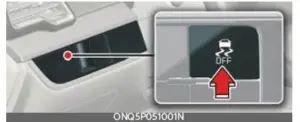
ESC applies the brakes on individual wheels and intervenes with the vehicle management system to stabilize the vehicle.
ESC will not prevent accidents. Excessive speed in turns, abrupt manoeuvres and hydroplaning on wet surfaces can still result in serious accidents.
Only a safe and attentive driver can pre-vent accidents by avoiding manoeuvres that cause the vehicle to lose traction. Even with ESC installed, always follow all the normal precautions for driving – including driving at safe speeds for the conditions.
WARNING
For maximum protection, always wear your seat belt. No system, no matter how advanced, can compensate for all driver error and/or driving conditions. Always drive responsibly.
The ESC system is an electronic system designed to help the driver maintain vehicle control under adverse conditions. It is not a substitute for safe driving practices. Factors including speed, road conditions and driver steering input can all affect whether ESC will be effective in preventing a loss of control. It is still your responsibility to drive and corner at reasonable speeds and to leave a sufficient margin of safety.
When you apply your brakes under conditions which may lock the wheels, you may hear a “tiktik” sound from the brakes, or feel a corresponding sensation in the brake pedal. This is normal and it means your ESC is active.
NOTICE
A click sound may be heard in the vehicle compartment when the vehicle begins to move after the vehicle is started. These conditions are normal and indicate that the Electronic Stability Control system is functioning properly.
ESC operation
ESC ON condition
- When the ENGINE START/STOP button is turned ON, ESC and ESC OFF indicator lights appear for approximately 3 seconds, then ESC is turned on.
- Press the ESC OFF button for at least half a second after turning the vehicle ON to turn ESC off. (ESC OFF indicator will appear). To turn the ESC on, press the ESC OFF button (ESC OFF indicator light will go off).
- When starting the vehicle, you may hear a slight ticking sound. This is the ESC performing an automatic system self-check and does not indicate a problem.
When operating
When the ESC is in operation, the ESC indicator light blinks.
When the Electronic Stability
Control is operating properly, you can feel a slight pulsation in the vehicle. This is only the effect of brake control and indicates nothing unusual.
When moving out of the mud or driving on a slippery road, pressing the accelerator pedal may not cause the vehicle rpm (revolutions per minute) to increase.
ESC operation off
This vehicle has 2 kinds of ESC off states.
If the vehicle stops when ESC is off, ESC remains off. Upon restarting the vehicle, the ESC will automatically turn on again.
 A: Traction Control disabled
A: Traction Control disabled
ESC off state 1
To turn off the traction control function and only operate the brake control function of the ESC, press the ESC OFF button (ESC OFF ) for less than 3seconds and the ESC OFF indicator light
(ESC OFF ) will appear.
ESC off state 1
To turn off the traction control function and only operate the brake control function of the ESC, press the ESC OFF button (ESC OFF ) for less than 3 seconds and the ESC OFF indicator light (ESC OFF ) will appear.
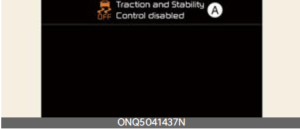
A: Traction and Stability Control disabled
ESC off state 2
To turn off the traction control function and the brake control function of the ESC, press the ESC OFF button (ESC
OFF ) for more than 3 seconds. ESC
OFF indicator light (ESC OFF ) will
appear and ESC OFF warning chime will sound. At this state, the vehicle stability control function does not operate any more.
Indicator light
ESC indicator light
ESC OFF indicator light
When ENGINE START/STOP button is turned to ON, the indicator light appears, then goes off if the ESC system is operating normally.
The ESC indicator light blinks whenever ESC is operating or appears when ESC fails to operate.
The ESC OFF indicator light comes on when the ESC is turned off with the button.
WARNING
Electronic Stability Control
Drive carefully even though your vehicle has Electronic Stability Control. It can only assist you in maintaining control under certain circumstances.
ESC OFF usage
When driving
- ESC should be turned on for daily driving whenever possible.
- To turn ESC off while driving, press the ESC OFF button while driving on a flat road surface.
WARNING
Operating ESC
Never press the ESC OFF button while ESC is operating (ESC indicator light blinks).
If ESC is turned off while ESC is operating, the vehicle may slip out of control.
NOTICE
- When operating the vehicle on a dynamometer, ensure that the ESC is turned off (ESC OFF light appeared). If the ESC is left on, it may prevent the vehicle speed from increasing, and result in false diagnosis.
- Turning the ESC off does not affect ABS or brake system operation.
Downhill Brake Control (DBC)
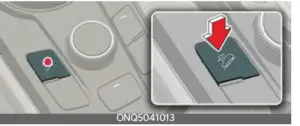
The Downhill Brake Control (DBC) feature assists the driver to descend down a steep hill without having to depress the brake pedal.
The system automatically applies the brakes to maintain the vehicle speed 2.5mph (4 km/h) ~ 25 mph (40 km/h) and allows the driver to concentrate on steering the vehicle down hill.
Always turn off the DBC on normal roads. The DBC might activate inadvertently from the stand by mode when driving through speed bumps or making sharp curves.
NOTICE
The DBC defaults to the OFF position whenever the ignition switch or ENGINE START/STOP button is placed in the ON position.
Noise or vibration may occur from the brakes when the DBC is activated. The rear stop light comes on when DBC is activated.
DBC operation
| Mode | Indicator light | Description |
|
Standby |
appear |
Press the DBC button when vehicle speed is under 38 mph (60 km/h). The DBC system will turn ON and enter the standby mode.
The system does not turn ON if vehicle speed is over 38 mph (60 km/h). |
|
Activated |
blinks |
In the standby mode, It enters the operating mode when the following conditions are met.
• The road surface should be more than a certain angle of inclination
• The vehicle speed should be within 2.5 mph (4 km/h) ~ 25 mph (40 km/h) Within operating vehicle speed 2.5 mph (4 km/h) ~ 25 mph (40 km/h), the driver can lower or raise the vehicle speed by stepping on the brake pedal or accelerator pedal. |
|
Temporarily deactivated |
appear |
In the activated mode, the DBC will temporarily deactivate under the following conditions:
• The hill is not steep enough. • The accelerator pedal is depressed. • When the vehicle speed is in the range of 25 mph (40 km/h) ~ 38 mph (60 km/ h) If the above conditions are not met, the DBC will automatically activate again. |
|
OFF |
not appeared |
The DBC will turn OFF under the following conditions:
• The DBC button is pressed again. • When the accelerator pedal is depressed and the vehicle speed exceeds 38 mph (60 km/h) |
NOTICE
If the DBC yellow indicator light appears, the system may have overheated or have malfunctioned. When the warning light appears even though the DBC system has cooled off, have your vehicle checked by an authorized Kia dealer as soon as possible.
NOTICE
- The DBC may not deactivate on steep inclines even though the brake or accelerator pedal is depressed.
- The DBC does not operate when:
- The gear is in P (Park).
- The ESC is activated.
Hill-start Assist Control (HAC)
A vehicle has the tendency to roll back on a steep hill when it starts to go after stopping. The Hill-start Assist Control
(HAC) prevents the vehicle from rolling back by applying the brakes automatically for about 2 seconds.
The brakes are released when the accelerator pedal is engaged or after about 2 seconds.
The HAC is activated only for about 2 seconds, so when the vehicle is starting off always engaged the accelerator pedal.
WARNING
Maintaining brake pressure on incline
HAC does not replace the need to apply brakes while stopped on an incline. While stopped, make sure you maintain brake pressure sufficient to prevent your vehicle from rolling backward and causing an accident. Don’t release the brake pedal until you are ready to accelerate forward.
Vehicle Stability Management(VSM) system
The Vehicle Stability Management (VSM) provides further enhancements to vehicle stability and steering responses under the following condition:
- when driving on a slippery road or
- when a change in the coefficient of friction between left and right wheels is detected.
WARNING
Tire/wheel size
When replacing tires and wheels, make sure they are the same size as the original tires and wheels installed. Driving with varying tire or wheel sizes may diminish any supplemental safety bene-fits of the VSM system.
VSM operation
When the VSM is operating properly, you can feel a slight pulsation in the vehicle and/or abnormal steering responses (Electric Power Steering
(EPS)). This is only the effect of brake and EPS control and indicates nothing unusual.
The VSM does not operate when:
- Driving on a sloping road such as a gradient or incline
- Driving in reverse
- ESC OFF indicator light ( ) remains on the instrument cluster
- EPS indicator light remains on the instrument cluster
VSM operation off
If you press the ESC OFF button to turn off the ESC, the VSM will also cancel and
the ESC OFF indicator light ( )
appears.
To turn on the VSM, press the button again. The ESC OFF indicator light goes out.
WARNING
Vehicle Stability Management
Drive carefully even though your vehicle has Vehicle Stability Management. It can only assist you in maintaining control of the vehicle under certain circumstances.
Malfunction indicator
The VSM can be deactivated even if you don’t cancel the VSM operation by pressing the ESC OFF button. It indicates that a malfunction has been detected somewhere in the Electric Power Steer-ing system or VSM system. If the ESC
indicator light ( ) or EPS warning light
remains on, take your vehicle and have the system checked by an authorized Kia dealer.
The VSM is not a substitute for safe driving practices but a supplementary function only. It is the responsibility of the driver to always check the speed and the distance to the vehicle ahead. Always hold the steering wheel firmly while driving.
Your vehicle is designed to activate according to the driver’s intention, even with installed VSM. Always follow all the normal precautions for driving at safe speeds for the conditions – including driving in clement weather and on a slippery road.
WARNING
For maximum protection, always wear your seat belt. No system, no matter how advanced, can compensate for all driver error and/or driving conditions. Always drive responsibly.
Trailer Stability Assist (TSA) system
The Trailer Stability Assist (TSA) is operated as a vehicle stability control system. The TSA is designed to stabilize the vehicle and trailer when the trailer sways or oscillates. There are various factors that make the vehicle sway or oscillate.
Such incidents mostly happen at high speed, but, there is also a risk of swaying when the trailer is affected by cross-winds, buffeting or improper overload-ing.
Factors of swaying such as:
- High speed
- Strong crosswinds
- Improper overloading
- Sudden controlling of steering wheel
- Uneven road
The TSA continuously analyzes the vehicle and trailer instability. When the TSA detects some sway, the brakes are applied automatically to stabilize the vehicle. When the vehicle becomes stable, the TSA does not operate.
Good braking practices
Good braking practices help keep occupants safe and extend brake life. - Check to be sure the parking brake is not engaged and the parking brake indicator light is out before driving away.
- Driving through water may get the brakes wet. They can also get wet when the vehicle is washed. Wet brakes can be dangerous! Your vehicle will not stop as quickly if the brakes are wet. Wet brakes may cause the vehicle to pull to one side.
To dry the brakes, apply the brakes lightly until the braking action returns to normal, taking care to keep the vehicle under control at all times. If the braking action does not return to normal, stop as soon as it is safe to do so and visit an authorized Kia dealer. - Don’t coast down hills with the vehicle out of gear. This is extremely hazard-ous. Keep the vehicle in gear at all times, use the brakes to slow down, then shift to a lower gear so that vehicle braking will help you maintain a safe speed.
- Don’t “ride” the brake pedal. Resting your foot on the brake pedal while driving can be dangerous because the brakes might overheat and lose their effectiveness. It also increases the wear of the brake components.
- If a tire goes flat while you are driving, apply the brakes gently and keep the vehicle pointed straight ahead while you slow down. When you are moving slowly enough for it to be safe to do so, pull off the road and stop in a safe place.
- Be cautious when parking on a hill.
Firmly engage the parking brake and place the shifter dial in P. If your vehi-cle is facing downhill, turn the front wheels into the curb to help keep the vehicle from rolling.
If your vehicle is facing uphill, turn the front wheels away from the curb to help keep the vehicle from rolling. If there is no curb or if it is required by other conditions to keep the vehicle from rolling, block the wheels. - Under some conditions your parking
brake can freeze in the engaged position. This is most likely to happen when there is an accumulation of snow or ice around or near the rear brakes or if the brakes are wet. If there is a risk that the parking brake may freeze, apply it only temporarily while you put the shifter dial in P
(Parking) and block the rear wheels so the vehicle cannot roll. Then release the parking brake.
- Do not hold the vehicle on an incline with the accelerator pedal. This can cause the transmission to overheat. Always use the brake pedal or parking brake.
FAQ
The 2023 Kia Sportage PHEV is equipped with a hydraulic brake system, which is standard in most vehicles.
Yes, the Sportage PHEV features regenerative braking, which helps recharge the vehicle’s battery while braking or decelerating.
The regenerative braking system in the Sportage PHEV converts kinetic energy into electrical energy, which is stored in the vehicle’s battery for later use.
Regenerative braking helps improve energy efficiency by recapturing and storing energy that would otherwise be lost as heat during braking, thus extending the electric driving range.
The traditional friction braking system in the Sportage PHEV utilizes brake pads and rotors to slow down and stop the vehicle by applying pressure to the wheels, creating friction and heat.
Brake pad lifespan can vary depending on driving habits and conditions, but typically, they may last between 30,000 to 70,000 miles.
Yes, the Sportage PHEV is likely equipped with an anti-lock braking system (ABS) that helps prevent wheel lock-up during hard braking, improving control and stability.
Many modern vehicles, including Kia models, are equipped with electronic brake-force distribution (EBD) to optimize brake force distribution for improved braking performance.
Brake rotor sizes can vary by trim level and specifications. Refer to Kia’s official documentation or contact a dealership for precise rotor size details.
Brake assist systems are common in modern vehicles, including Kia models, and may be included in the Sportage PHEV for added braking assistance during emergency stops.
The Sportage PHEV may feature advanced safety systems, such as automatic emergency braking, which can use the brake system to help avoid collisions.
Regular brake system inspections and maintenance are essential for safety. Consult the owner’s manual for recommended service intervals and consult with a Kia service center.
Towing capacity can vary by trim level and specifications. Check the owner’s manual or Kia’s official documentation for information on towing capacity.
Some models of the Sportage may offer a hill descent control feature, which can aid in off-road descents by controlling the vehicle’s speed using the brake system.
The brake system in the Sportage PHEV plays a crucial role in ensuring both safety and performance, with regenerative braking for improved efficiency and traditional friction brakes for reliable stopping power, making it a well-rounded choice for drivers seeking a balance between sustainability and safety.
Useful Link
View Full User Guide: Kia Sportage PHEV 2023 User Guide
Download Manuals: https://owners.kia.com/content/owners/en/manuals.html
2023 KIA SPORTAGE Specs, Price, Features and Mileage (Brochure)

